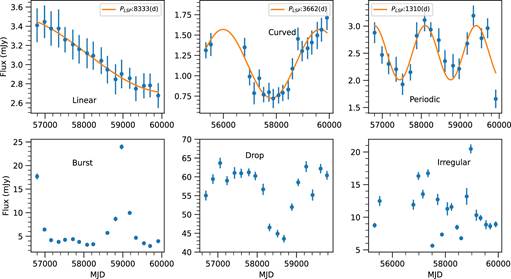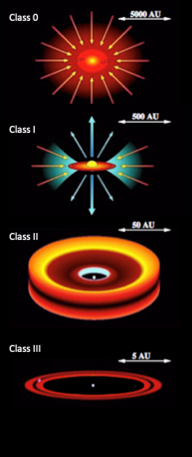Ministry of Science & Technology
A decade of data from NASA unveils dramatic secrets of stellar infancy
प्रविष्टि तिथि:
26 NOV 2025 3:43PM by PIB Delhi
A sweeping new study has pulled back the curtain on the chaotic early lives of young stars, revealing that stellar infancy is far more turbulent and variable than previously thought.
Over ten years of data from NASA’s Wide-field Infrared Survey Explorer (WISE) and its extended mission NEOWISE, astronomers have now captured one of the largest and most detailed mid-infrared variability catalogs of young stellar objects (YSOs) to date.
Young Stellar Objects (YSO) are stars in the earliest stages of their lives where stars stably fuse hydrogen in their cores. This is the stage before the stars enter the main sequence of what is called the Hertzsprung-Russell diagram (a plot showing stars in various stages of evolution based on their temperature and brightness). YSOs form from the collapse of dense molecular clouds, giant cold regions in space rich in gas and dust.
This collapse can be triggered by various events—such as nearby supernova explosions, stellar radiation, or turbulence in the interstellar medium—that cause local over-densities and gravitational instability.
Published in The Astrophysical Journal Supplement Series, a study by Neha Sharma and Saurabh Sharma from the Aryabhatta Research Institute of Observational Sciences (ARIES), an autonomous institute under the Department of Science & Technology (DST), Govt. of India, analyzed light curves for over 22,000 YSOs across various massive star-forming regions in our galaxy. These regions serve as natural laboratories for understanding how stars are born and evolve.
They found that as the dense molecular clouds contracts under their own gravity, at their center forms a protostar—a hot, dense core surrounded by a rotating disk of material. The protostar emits light not from fusion but from the heat generated by gravitational collapse and mass accretion.
With time, material from the surrounding disk continues to deposit onto the protostar, feeding its growth. This process is inherently unstable, with sudden bursts and lulls in accretion that can lead to rapid and unpredictable changes in brightness. Eventually, the radiation pressure from the growing star can expel the remaining cloud material, halting accretion and leaving behind a young, pre-main-sequence star.
These dynamic processes are what make YSOs such rich subjects for infrared monitoring. Infrared light penetrates the thick dust shrouds surrounding YSOs—offering a unique window into the otherwise hidden early evolution of stars.
By analyzing over a decade of WISE/NEOWISE infrared observations at 3.4 and 4.6 microns, the team classified YSO variability into six main categories: Linear (steady brightening or fading), Curved (nonlinear trends), Periodic (repeating patterns tied to rotation or disk orbit), Burst (sudden brightening), Drop (abrupt dimming), and Irregular (erratic, chaotic changes).

Fig 1. Example light curves of different types of variables: linear, curved, periodic, burst, drop, and irregular from left to right.

Fig 2: Schematic representation of the four evolutionary stages of protostars (adapted from Andrea Isella’s 2006 thesis). Class 0 objects are deeply embedded in a dense envelope, with a small central core. In Class I, the core continues to grow, and a flattened circumstellar disk begins to form. By Class II, most of the surrounding material has settled into a prominent disk of gas and dust. In the final Class III stage, the disk has largely dissipated, and the star's spectral energy distribution resembles that of a mature stellar photosphere
Roughly 26% of the YSOs exhibited detectable variability, with irregular changes being the most frequent. Notably, younger stars—particularly Class I YSOs, which are still deeply embedded in their dusty envelopes—were far more variable, with 36% showing changes compared to 22% of more evolved Class III stars, whose circumstellar disks have mostly dissipated.
Color changes revealed further clues. While most variable stars became redder when they brightened—a likely sign of dust heating or increased extinction—a significant minority showed the opposite trend, becoming bluer when brightening. This behavior was more common in the youngest YSOs and may signal enhanced accretion episodes or structural clearing of inner disk material.
“This catalog offers one of the most complete mid-infrared views of stellar youth,” said lead author Neha Sharma. “By studying their flickers, we can uncover how stars grow, feed, and shed their dusty wombs.”
The publicly available catalog includes over 5,800 variable YSOs, providing a rich dataset for astronomers exploring the interplay between accretion, disk evolution, and stellar formation. As observatories like the James Webb Space Telescope (JWST) and 3.6m Devasthal Optical Telescope (DOT) begin to follow up on these findings with even greater sensitivity and resolution, researchers anticipate uncovering the fine details of how stars like our Sun emerged from darkness.
Publication Link: https://doi.org/10.3847/1538-4365/adc397
****
NKR/AK
(रिलीज़ आईडी: 2194662)
आगंतुक पटल : 49